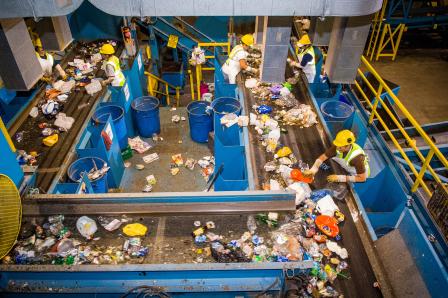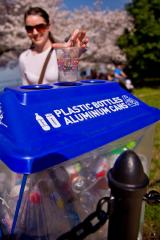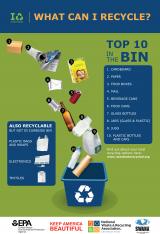America Recycles Day

On America Recycles Day 2019 (November 15), EPA recognized the importance and impact of recycling, which has contributed to American prosperity and the protection of our environment. The recycling rate has increased from less than 7 percent in 1960 to the current rate of 32 percent. An EPA study found that recycling and reuse activities in the United States accounted for 681,000 jobs and $37.8 billion in wages.
The recycling efforts of communities and business throughout the United States have helped with this success and growth. To build on our progress, EPA encourages every American to contribute by recycling right, not only on every annual America Recycles Day, but all year. This means checking with your local recycling provider to be certain that they will accept everything you place in your recycling bin. Items like cardboard, metal cans and paper are commonly accepted by local curbside programs, and items like plastic bags, electronics and batteries can NEVER go in the curbside recycling bin. Visit our How Do I Recycle?: Common Recyclables to see how and where to recycle these and other items.
On this page:
- Benefits of recycling
- What you can do to reduce waste
- Recycling saves resources and creates jobs
- Recycle More, Recycle Right
- Save energy by recycling
- Resources for educators
Benefits of Recycling
- Reduces the amount of waste sent to landfills and incinerators
- Conserves natural resources such as timber, water and minerals
- Increases economic security by tapping a domestic source of materials
- Prevents pollution by reducing the need to collect new raw materials
- Saves energy
- Supports American manufacturing and conserves valuable resources
- Helps create new well-paying jobs in the recycling and manufacturing industries in the United States
What You Can Do To Reduce Waste
Find out what you can do to help make a difference in our environment every day. Whether you're at home, on the go, in the office or at school, there are many opportunities to go green by reducing, reusing and recycling. Visit the links below to see how, and check out our Think Green Before You Shop poster for questions you can ask yourself before shopping to reduce, reuse and recycle more.
Recycling Saves Resources and Creates Jobs
 To celebrate America Recycles Day in 2016, EPA released significant findings on the economic benefits of the recycling industry with an update to the national Recycling Economic Information (REI) Study. This study analyzes the numbers of jobs, wages and tax revenues attributed to recycling. The study found that in a single year, recycling and reuse activities in the United States accounted for:
To celebrate America Recycles Day in 2016, EPA released significant findings on the economic benefits of the recycling industry with an update to the national Recycling Economic Information (REI) Study. This study analyzes the numbers of jobs, wages and tax revenues attributed to recycling. The study found that in a single year, recycling and reuse activities in the United States accounted for:
- 681,000 jobs
- $37.8 billion in wages; and
- $5.5 billion in tax revenues.
This equates to 1.17 jobs for every 1,000 tons of materials recycled.
The ferrous metals industry provides the largest contribution to all three categories (job, wage, and tax revenue), followed by construction and demolition (C&D) and non-ferrous metals such as aluminum.
For more information, check out the full report.
Recycle More, Recycle Right
How often do you ask yourself what's right to put in your recycling bin? Next time you go to throw something away, get creative and think of ways to reduce waste in the first place! There are many ways to improve the recycling rate. Check out our What You Can Do to Improve the Recycling Rate fact sheet for ideas on how you can improve your recycling. Additionally, see our poster to the right and our How Do I Recycle?: Common Recyclables web page to learn how to recycle more and recycle right.
Check out our Frequent Questions on Recycling page for more information on ways you can contribute and where.
Save Energy By Recycling
Recycling everyday objects, such as paper, bottles and magazines saves energy. The materials that you recycle are used to create the products you buy. This means less virgin material needs to be mined or harvested, processed, manufactured and transported - all of which consume energy. The iWARM tool is based on EPA's Waste Reduction Model (WARM) for solid waste planners and organizations. iWARM can be used to calculate how much energy organizations can save and how much greenhouse gases they can avoid by recycling versus landfilling their waste.
Resources for Educators
Educators: Our Reduce, Reuse, Recycle Resources for Students and Educators web page has resources and activities for this America Recycles Day. Most of these resources are also available to order in hard copy.


